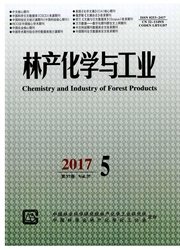

 中文摘要:
中文摘要:
以速生杨二步超低酸水解方法获得的水解液为原料,在28℃、100r/min等发酵条件下,选择热带假丝酵母(C,2,637)和酿酒酵母(S,2.699)分别对第一步和第二步水解液进行了发酵制取燃料乙醇的研究,并考查了Ca(OH)2中和、过中和、活性炭吸附等预处理方法及菌种预适应驯化对乙醇转化率的影响。结果表明:热带假丝酵母能够更好地利用第一步水解液生成菌体,适合生产单细胞蛋白;菌种驯化后发酵速度和乙醇转化率均有提高,尤其是以酿酒酵母发酵第二步水解液,乙醇转化率由14.45%增至39.37%;Ca(OH)2过中和的方法处理后的水解液,乙醇转化率有所增加;以五碳糖为主同时含有六碳糖的速生杨第一步水解液,假丝酵母发酵产乙醇的效果好于酿酒酵母。
 英文摘要:
英文摘要:
Choosing hydrolyzate of poplar as fermentation material, which was obtained by two-step super-low acids hydrolysis, fuel ethanol production was studied by using Candida tropicalis 2.637 and Saccharomyces cerevisiae 2. 699 respectively. Simultaneously the influences to the ethanol yield by various pretreatment methods, such as Ca( OH)2 neutralization, over-neutralization, active carbon adsorption and yeast-training were carried out. The experimental results show that C. tropicalis 2. 637 is suitable to the first-step hydrolyzate rich in pentose to produce single cell protein. Yeast-training can improve fermentation speed and increase ethanol yield, especially to the second step hydrolyzate through which ethanol yield was increased from 14.45 % to 39.37 % by S. cerevisiae 2. 699. The over-neutralization of hydrolyzate by Ca(OH)2 improved ethanol yield, too. Therefore,for the hydrolysis of the first-step hydrolyzate, which contains mainly pentose and accompanied with hexose, more ethanol can be obtained by C. tropicalis 2. 637 than by S. cerevisiae 2. 699.
 同期刊论文项目
同期刊论文项目
 同项目期刊论文
同项目期刊论文
 期刊信息
期刊信息
